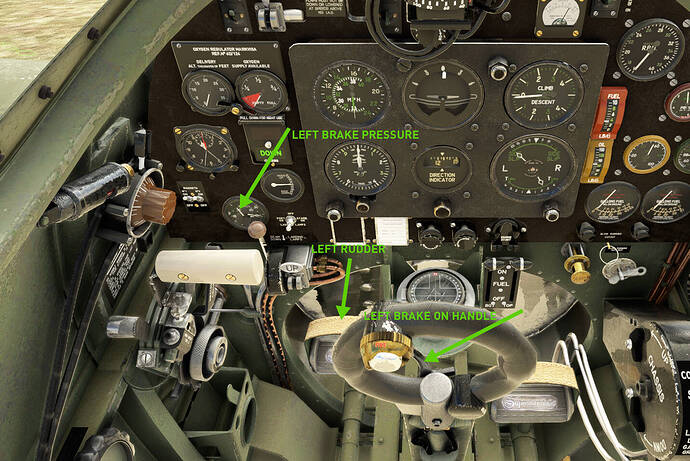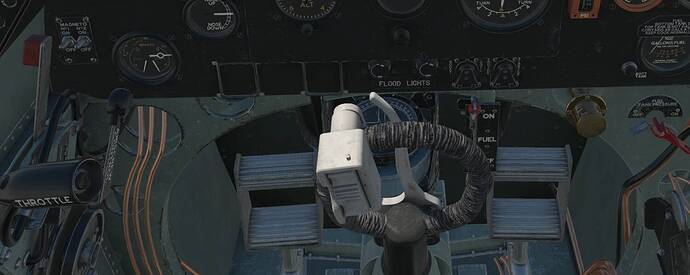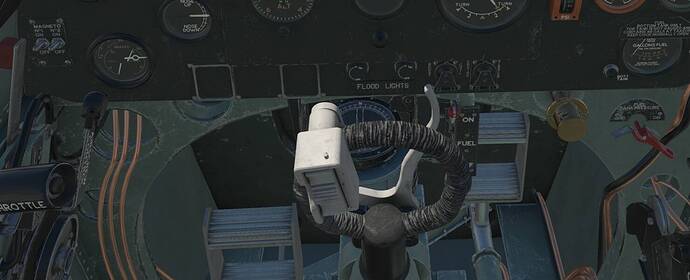Yes, the normal wheel brake key assignment works fine to operate the handle. Also I found in the prior version that there may be more than one config because opposite braking occurred on one default paint I flew but was different in another default paint (possibly the refreshed model versus the in-service paint, don’t remember the names used and I’m away from my PC for a while).
You bind your trigger to both left and right wheel brakes as in the Mk9.
Are you telling me then that without brakes applied the Spitfire cannot be turned on the ground? I doubt that very much. Prop wash on the rudder alone would be enough.
There is a de-icer spray bar and a control but currently it is inop.
Aerodynamic effect of the rudder is the same as any aircraft, all relative to airflow across it and so it will influence turning with enough power applied but that is entirely off the point as that effect occurs in your model with minimal thrust as it currently turns without any effort to energise it. The point here is that differential braking is the normal means to turn a Spitfire on the ground which is applied through both rudder input AND use of the brake control.
Clearly you don’t want to hear it, so I’ll leave that here, there’s no point beating a dead donkey,
I think what hes trying to say is that this model turns too easily with just air over the rudder. It acts like the brake is already applied, which its not. I think what would be good is only do the sharp turns if some brake is applied like the real thing as this can basically spin with very little throttle and no brake applied at all.
I think this is what you are trying to get at @Jetstreamsky?
Listen to this video at 10 mins 15 secs to 30 seconds where the pilot Dave Hadfield is controlling a turn using the rudder and inducing a tightening or reversal of the turn through several brief applications of the brake which you can hear venting into the cockpit as a chhhh sound, which he explains in a separate video is the braking system venting directly into the cockpit and in yet another he says the squeaking sound is control rods from the rudder passing through a dry felt bearing and is completely normal. https://www.youtube-nocookie.com/embed/FW2N9ErhbB8
Once a turn is induced, the castoring tail wheel will keep it going so braking is not needed to maintain it but is used to adjust and eventually stop it. This method was typical on British aircraft of that era, so isn’t unique to the Spitfire.
Aaah - OK - thanks!!! I thought it was my failing eyesight! LOL! Is there any way (temporary kludge?) that we can stop the effect happening? I’ve been messing with REX live weather (and it’s winter here in NZ) so I tend to run into cold weather quite a lot.
I spent 10 years in NZ before moving to Queensland here in Oz. We will be including the deice issue in the next Upgrade which we hope to deliver some time next week. So if you can hand on til then. Maybe take some flights in Queensland where it is warm and the sun shines every day…
Thanks for putting the deicer on the list. I’ve been in NZ for 20yrs, but have some great friends in Queensland - and have fond memories of Noosa/Fraser Island etc.
We’re in Hervey Bay. Fraser with reach from breakfast on the beach. It’s a hard life.
Here is shot from our Spitfire during a left turn on the ground. As you can see I am pressing the left pedal, the brake handle on the grip is squeezed a little and the gauge is showing left brake pressure. Please tell me if all of this is wrong because all I am trying to understand is where I need to correct if necessary.
Two things I think I see: The pressure for the left wheel brake does not correspond with the brake lever position i.e. the lever should be all the way to the right: I am not aware that the brake lever in sim can be proportional?. It looks like the brake lever is in the released position i.e. on or off as the trigger is a switch? Also, assuming the rudder is full left, why does it look like the right wheel needle in the gauge is showing some pressure to the right wheel brake? Maybe it’s the angle of the screen shot?
Please forgive me if I’m being daft.
From what I understand, there is always brake pressure in both wheels but differential via rudder input increases pressure to the left (in this case). The handle was on its way to full right side of the grip when this shot was taken. The braking is only momentary otherwise you come to a full stop.
I agree. When the lever is full right, such as when the parking brake is set, there is equal pressure to both brakes. When released and rudder at neutral, no pressure to either. Thus, when rudder off neutral, surely pressure increases to the rudder direction as you point out. I’m not sure though why it would make sense that pressure also partially diverts to the opposite brake unless it is purely a limitation in the sim coding (switch v axis - since if one assigns toe brakes to experiment, pressure only increases right or left, or both when +/- applied equally) rather than RL. I’ll check via some Spitfire pilots I have access to. Otherwise, maybe there’s something on the net/youtube somewhere.
I just checked the Flyingiron Mk 9 in X-plane. My control settings, trigger etc. identical to MSFS.
It’s an issue with MSFS for certain.
Effect of partial right rudder - to complete the picture. So, yes, unless full rudder, some pressure maintained on opposite wheel. But, MSFS will not hold at just partial pressure.
So I just looked at all this in detail and found the following:
Using the Brake binding shows both both needles move when applied with rudder centred as expected and bring the aircraft to a stop.
The Brake binding moves right needle just before left needle when right rudder is applied and aircraft turns right and vice versa but aircraft will turn anyway without any brake even at the lowest possible power setting or just rolling power all the way back, so no real affect from the brake anyway, certainly shouldn’t be due to airflow over the rudder. Not sure if left needle should move in this scenario, cannot find anything saying if the air pressure is split or completely diverted, I suspect split so you can stop in a turn.
However, you can simply taxi and turn at minimal thrust not using brakes at all, even in very tight turn so they aren’t figuring in the turn dynamics even if modelled.
I also found that Right Brake binding which should not be available as such, will in fact drive the right needle without follow up from the left needle unlike the behaviour of the normal brake binding, but it brakes the opposite wheel and so the aircraft will turn on brake alone without rudder input the wrong way. Vice versa for Left Brake.
These behaviours are why we’re not seeing the same thing as it depends on what you expect and how you apply it.
Those using left or right brake bindings will see opposite turns, those using brake and rudder will see a turn but they needn’t have bothered with the brake as the same turn occurs without using it.
I hope this helps to clear this up.
Cheers
As a side note, the tailwheel castors on ground ok, but is turning with the rudder in the air, but you have to look close to catch it. ![]()
That is my observation. Right Rudder means the right pressure needle moves first but then half a second later the left needle will follow it and visa versa with Left Rudder. Regardless of rudder position, after several seconds both needles are full on.
That may of course be how it really worked. No idea.




